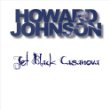If Howard Johnson turned up on one of those One Hit Wonder shows that Vh-1 does from time to time, it wouldn’t be surprising. It would also – depending on your definition of “hit” – be wrong. Johnson’s “one” hit would be the 1982 funk jam “So Fine,” a cut that made it to number 1 on the R&B charts that year and was all over black radio. Johnson scored another R&B chart topper in 1985 three years later with “Stand Up.” So Johnson actually had two hits. However, R&B fans from that era are more likely to recall “So Fine,” and in the inexact science of TV list shows that means something.
Still, the native south Floridian didn’t exactly waste away in Margaritaville after the 80s were done. Johnson could make the case that 1991 was an even bigger year. He produced the Barry White album Put Me in Your Mix and co-wrote the title track with White. Johnson also lent his vocals to the soundtrack to one of the best loved movies about the 1960s and 70s soul music era, The Five Heartbeats.
Johnson remained busy throughout the decade by producing music for artists such as Madonna, Boyz II Men and Tom Jones. He also performed as a member of the duo Johnson & Branson, as the front man for the reconstituted LTD and as a solo artist.
Johnson dropped several solo projects in recent years, with his most recent being this year’s Jet Black Casanova. This comes at a time when some of Johnson’s older material returns to a KISS-90 point something near you as those stations add more music from the early 1980s to their playlists. That will further cement that view of Johnson as a legacy act, which is a shame because Jet Black Casanova shows that Johnson is a talented artist who can operate in a variety of classic as well as more contemporary R&B styles.
Fans of early 1980s funk will gravitate to “That Look,” a track that bathes itself in that retro aesthetic right down to the thumping bass line and rhythmic hand claps. Johnson assumes the role of the balladeer with ease on the slow jams “I’m Taking A Chance” and “Wanna Satisfy.” The former will recall some of the best work of 1970s era groups such as Blue Magic with Johnson’s short opening monolog and the orchestral strings, while “Wanna Satisfy” recalls the smooth and sophisticated R&B slow jams that filled the airwaves in the mid and late 1980s.
“Right Where I Wanna Be” shows that Johnson studied musical trends dominating contemporary R&B. The production techniques endow the tune with a young sound while the lyrics - which tell the story of a man who is at the right place with his relationship - will go over well with the adult set.
The title track is interesting: It addresses the still relevant issue of skin color and class in the black community. “Jet Black Casanova” is the tale of a romance involving a man and woman who reside on opposite sides of the skin color and class divide. Johnson sings the song from the perspective of a man recounting a romance from his distant youth. The sad fact is that these skin color and class distinctions regularly rear their heads in 2013. Johnson rounds out Jet Black Casanova with three songs – “Mama Loves,” “I Wish You Were Here” and “What Will I Say” – that are imbued with the sound of Memphis. “Mama Loves” and “What Will I Say” harken back to Stax while “Wish You Were Here” is homage to Al Green and Hi records.
Howard Johnson takes listeners on a musical journey from the Memphis of the late 60s and early 70s to the urban adult music of 21st Century, and although he covers a lot ground, his Jet Black Casanova is a focused project never sounds disjointed or unwieldy. It sounds like the product of an underrated artist who is hitting his prime. Recommended.
By Howard Dukes

